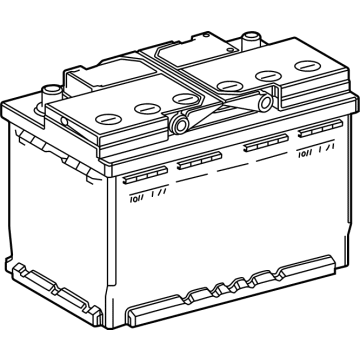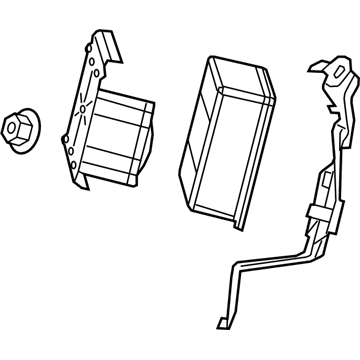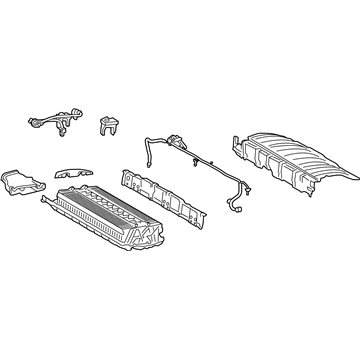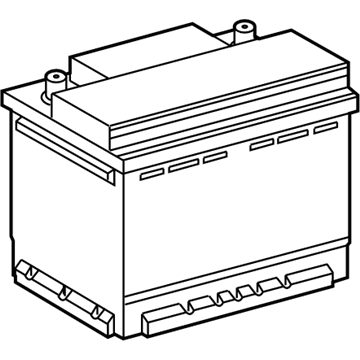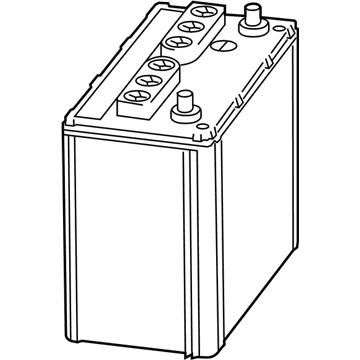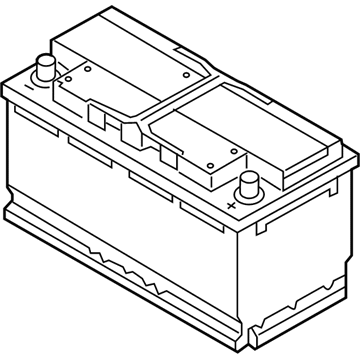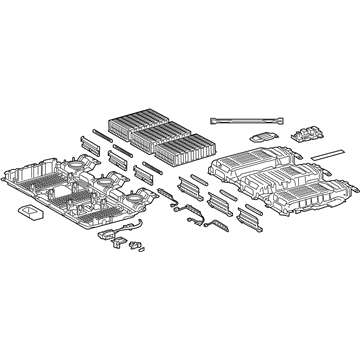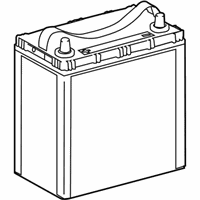×
ToyotaParts- Hello
- Login or Register
- Quick Links
- Live Chat
- Track Order
- Parts Availability
- RMA
- Help Center
- Contact Us
- Shop for
- Toyota Parts
- Scion Parts
My Garage
My Account
Cart
OEM Toyota Car Batteries
Auto Battery- Select Vehicle by Model
- Select Vehicle by VIN
Select Vehicle by Model
orMake
Model
Year
Select Vehicle by VIN
For the most accurate results, select vehicle by your VIN (Vehicle Identification Number).
82 Car Batteries found
Toyota Battery
Part Number: 28800-31572$1005.34 MSRP: $1473.33You Save: $467.99 (32%)Ships in 1-2 Business DaysToyota Battery
Part Number: 86770-47010$3596.04 MSRP: $5270.05You Save: $1674.01 (32%)Ships in 1-3 Business DaysProduct Specifications- Other Name: Battery Assembly, Mayday
Toyota Battery
Part Number: 00286-22F50$60.27 MSRP: $84.59You Save: $24.32 (29%)Ships in 1-3 Business DaysProduct Specifications- Other Name: Battery, 22F, Wet/Acid
- Replaces: 00286-22F36
Toyota Battery
Part Number: 00286-35060-RC$78.25 MSRP: $109.84You Save: $31.59 (29%)Ships in 1-3 Business DaysProduct Specifications- Other Name: Battery Rc Group 35 60M
- Replaces: 00286-35060-MF
Toyota Battery
Part Number: 00286-27060-RC$82.62 MSRP: $115.96You Save: $33.34 (29%)Ships in 1-3 Business DaysProduct Specifications- Other Name: Battery Rc Group 27 60M
- Replaces: 00286-27060-MF
Toyota Battery
Part Number: G9510-48151$8874.04 MSRP: $13858.99You Save: $4984.95 (36%)Ships in 1-2 Business DaysProduct Specifications- Other Name: Battery Assembly, Hev Su; Battery Assembly, HV Supply
Toyota Battery Assembly
Part Number: G9510-30110$8130.04 MSRP: $12768.66You Save: $4638.62 (37%)Ships in 1-2 Business DaysProduct Specifications- Other Name: Battery Assembly, Hv Supply
Toyota Battery Assembly
Part Number: G9510-30100$8247.33 MSRP: $12940.53You Save: $4693.20 (37%)Ships in 1-2 Business DaysProduct Specifications- Other Name: Battery Assembly, Hv Supply
Toyota Battery
Part Number: G9510-48141$8330.99 MSRP: $12167.62You Save: $3836.63 (32%)Ships in 1-2 Business DaysProduct Specifications- Other Name: Battery Assembly, Hev Su; Battery Assembly, HV Supply
Toyota Battery
Part Number: G9510-42050$2674.04 MSRP: $3365.69You Save: $691.65 (21%)Ships in 1-3 Business DaysProduct Specifications- Other Name: Battery Assembly, Hv Supply
Toyota Battery Assembly
Part Number: G9510-62020$3923.65 MSRP: $4938.51You Save: $1014.86 (21%)Ships in 1-3 Business DaysProduct Specifications- Other Name: Battery Assembly, Hev Su; Drive Motor Battery Pack; Battery Assembly, EV Supply; Battery
Toyota Battery Assembly
Part Number: G9510-48110$2674.04 MSRP: $3365.69You Save: $691.65 (21%)Ships in 1-3 Business DaysProduct Specifications- Other Name: Battery Assembly, Hv Supply; Drive Motor Battery Pack Assembly; Battery
Toyota Battery
Part Number: 00544-H7EFB-TS$254.55 MSRP: $302.43You Save: $47.88 (16%)Ships in 1-3 Business DaysProduct Specifications- Other Name: Truestart H7
Toyota Battery
Part Number: 00544-H7SLI-TS$201.48 MSRP: $239.37You Save: $37.89 (16%)Ships in 1-3 Business DaysProduct Specifications- Other Name: Truestart H7
Toyota Battery
Part Number: 00544-H6EFB-TS$216.81 MSRP: $257.59You Save: $40.78 (16%)Ships in 1-3 Business DaysProduct Specifications- Other Name: Truestart H6 Efb
Toyota Battery
Part Number: 28800-31292$244.84 MSRP: $291.89You Save: $47.05 (17%)Ships in 1-2 Business DaysProduct Specifications- Replaced by: 28800-31293
Toyota Battery
Part Number: 00544-H8AGM-TS$264.11 MSRP: $313.78You Save: $49.67 (16%)Ships in 1-3 Business DaysProduct Specifications- Other Name: Truestart H8 Agm
Toyota Battery Assembly
Part Number: G9510-48120$4005.59 MSRP: $5002.79You Save: $997.20 (20%)Ships in 1-3 Business DaysProduct Specifications- Other Name: Battery Assembly, Hv Supply; Battery
- Replaces: G9510-48070
- Product Specifications
- Other Name: Battery Assembly, Ev Sup; Battery; Battery Assembly, EV Supply
Toyota Battery
Part Number: G9510-34010$4005.59 MSRP: $5002.79You Save: $997.20 (20%)Ships in 1-3 Business DaysProduct Specifications- Other Name: Battery Assembly, Hev Su; Battery Assembly, HV Supply
| Page 1 of 5 |Next >
1-20 of 82 Results
Toyota Car Batteries
Choose genuine Car Batteries that pass strict quality control tests. You can trust the top quality and lasting durability. Shopping for OEM Car Batteries for your Toyota ? Our website is your one-stop destination. We stock an extensive selection of genuine Toyota parts. The price is affordable so you can save more. It only takes minutes to browse and find the exact fit. Easily add to cart and check out fast. Our hassle-free return policy will keep you stress-free. We process orders quickly for swift delivery. Your parts will arrive faster, so you can get back on the road sooner.
Toyota Car Batteries Parts and Q&A
- Q: What happens when the auxiliary Car Batteries is replaced or the cable is disconnected from its negative (-) Car Batteries terminal on Toyota Prius?A:The ISC learning value resets after auxiliary battery replacement or negative (-) battery terminal cable disconnect thus the hybrid vehicle transaxle assembly in USA and Canada may produce noises and the hybrid vehicle transaxle assembly in other regions may experience high idle speed and noise. Performing ISC learning becomes essential after either battery replacement or negative (-) terminal cable disconnection from the auxiliary battery for achieving proper vehicle functioning.
- Q: What procedures and initializations are required when replacing or reconnecting components related to the Car Batteries, ECU, transmission, tire pressure system, steering, and key systems on Toyota Venza?A:Engine startup and steering lock release will be prevented after battery terminal changes unless the steering lock system runs its initialization sequence because of low battery voltage. To replace the ECU or other components dealers should use Techstream through which they must operate two functions: first they should read the VIN from the old ECU then they should apply the new VIN to the replacement ECM only when the stored VIN does not match the actual VIN of the vehicle. The Techstream requires resetting of the transaxle compensation code after replacing either the valve body assembly or shift solenoid valves SL3 and SL4 or TCM through a step-by-step procedure that starts with putting the shift lever to N or P then opening the ignition before proceeding to the Techstream menus. The TCM needs a road test to learn after memory reset since this procedure requires the Techstream for execution. The transaxle compensation code from the QR label must be recorded before reinstallation into the TCM since the correct 60-digit alphanumeric value is needed to prevent shift shock. The procedure for tire pressure warning systems entails using the Techstream to register transmitter IDs that become necessary during component replacement. Beforehand technicians should collect ID data using the Techstream as the tool for registration. The vehicle stability control system calibration needs an engine variant learning procedure through Techstream that follows specific steps to guarantee system functionality. When changing the power steering ECU or steering column assembly the system demands an initialization process for the rotation angle sensor while performing a calibration of the torque sensor zero point. When components need replacement in wireless door lock control systems without a smart key systems the registration process for recognition codes follows a set sequence of modes which includes adding, rewriting, confirming and prohibition of codes. Users need to register ID codes in the engine immobiliser system to activate both smart key functionality and related features and the Techstream performs the key addition and replacement procedures.
Related Toyota Parts
Browse Toyota Car Batteries by Models
Tacoma 4Runner Camry Tundra Corolla RAV4 Highlander Prius Sienna Land Cruiser Pickup FJ Cruiser 86 Sequoia T100 Avalon Celica Supra Yaris MR2 Matrix Solara Venza Echo C-HR Cressida Grand Highlander Paseo Prius C Prius Prime Corolla Cross Corolla iM Crown GR Corolla MR2 Spyder Mirai Prius V Starlet Tercel Yaris iA bZ4X Prius Plug-In GR Supra Prius AWD-e RAV4 Prime
